Composition and Genesis of Dark Dolomite-Type Nephrite in the Kavokta Deposit, Middle Vitim Mountain Country, Russia
Abstract
1. Introduction
2. Materials and Methods
3. Geology of the Kavokta Deposit
4. Results
4.1. Geology of the South-Eastern Area of the Deposit
4.2. South-Eastern Area Nephrite Petrography, Minerals Chemistry, and Carbon Isotope Ratios
4.3. Geology of the North-Western Area of the Deposit
4.4. North-Western Area Nephrite Petrography and Minerals Chemistry
5. Discussion
6. Conclusions
Author Contributions
Funding
Data Availability Statement
Acknowledgments
Conflicts of Interest
References
- Kievlenko, E.Y. Geology of Gems; Ocean Publications Ltd.: Littleton, CO, USA, 2003; 432p. [Google Scholar]
- Harlow, G.E.; Sorensen, S.S. Jade (Nephrite and Jadeitite) and Serpentinite: Metasomatic Connections. Int. Geol. Rev. 2005, 47, 113–146. [Google Scholar] [CrossRef]
- Voskova, O.V.; Kovtonyuk, G.P. The State Balance of Mineral Reserves of the Russian Federation as of January 1, 2024. In Colored Stones; Federal State Budgetary Institution “Russian Federal Geological Foundation”: Moscow, Russia, 2024; 284p. (In Russian) [Google Scholar]
- Sotnikova, V.F.; Sungatullin, R.K.h.; Kislov, E.V. First Mineralogical and Geochemical Data on Placer Nephrite in the Vitim Highland, Republic of Buryatia. Lithol. Min. Resour. 2025, 60, 333–345. [Google Scholar] [CrossRef]
- Zhong, Q.; Liao, Z.; Qi, L.; Zhou, Z. Black nephrite jade from Guangxi, Southern China. Gems Gemol. 2019, 55, 198–215. [Google Scholar] [CrossRef]
- Casadio, F.; Douglas, J.G.; Faber, K.T. Noninvasive methods for the investigation of ancient Chinese jades: An integrated analytical approach. Anal. Bioanal. Chem. 2007, 387, 791–801. [Google Scholar] [CrossRef]
- Douglas, J.G. The study of Chinese archaic jades using non-destructive X-ray fluorescence spectroscopy. Acta Geol. Taiwan 1996, 32, 43–54. [Google Scholar]
- Wilkins, C.J.; Tennant, W.C.; Williamson, B.E.; Mccammon, C.A. Spectroscopic and related evidence on the coloring and constitution of New Zealand jade. Am. Mineral. 2003, 88, 1336–1344. [Google Scholar] [CrossRef]
- Liu, Y.; Deng, J.; Shi, G.; Sun, X.; Yang, L. Geochemistry and petrology of nephrite from Alamas, Xinjiang, NW China. J. Asian Earth Sci. 2011, 42, 440–451. [Google Scholar] [CrossRef]
- Liu, Y.; Deng, J.; Shi, G.; Sun, X.; Yang, L. Geochemistry and petrogenesis of placer nephrite from Hetian, Xinjiang, Northwest China. Ore Geol. Rev. 2011, 41, 122–132. [Google Scholar] [CrossRef]
- Zheng, J.; Chen, L.; Zhang, C.; Liu, Y.; Tian, R.; Wu, J.; Wu, Y.; Zhang, S. Constraints on Crystallinity of Graphite Inclusions in Nephrite Jade from Xinjiang, Northwest China: Implications for Nephrite Jade Formation Temperatures. Minerals 2023, 13, 1403. [Google Scholar] [CrossRef]
- Fang, T.; Chang, Y.; Yang, M. Nephrite from Xinjiang Qiemo-Margou Deposit: Gemological and Geochemical Insights. Minerals 2024, 14, 458. [Google Scholar] [CrossRef]
- Zhang, C.; Yu, X.; Jiang, T. Mineral association and graphite inclusions in nephrite jade from Liaoning, northeast China: Implications for metamorphic conditions and ore genesis. Geosci. Front. 2019, 10, 425–437. [Google Scholar] [CrossRef]
- Gong, N.; Wang, C.; Xu, S. Color Origin of Greyish-Purple Tremolite Jade from Sanchahe in Qinghai Province, NW China. Minerals 2023, 13, 1049. [Google Scholar] [CrossRef]
- Flint, D.J.; Dubowski, E.A. Cowell Jade Province: Detailed Geological Mapping and Diamond Drilling of Jade and Ornamental Marble Outcrops, 1982–1987; Department of mines and energy of South Australia: Adelaide, Australia, 1989; Rept. Bk. No. 89/51. Dme No. 85/88; Volume 1, 323p. [Google Scholar]
- Adamo, I.; Bocchio, R. Nephrite jade from Val Malenco, Italy: Review and Update. Gems Gemol. 2013, 49, 98–106. [Google Scholar] [CrossRef]
- Shi, G.; Jia, R.; Santosh, M.; Liang, H.; He, Y. First report of a nephrite deposit from Somaliland, Africa: Characterization and geological and archaeological implications. Geol. Soc. Am. Bull. 2024, 136, 661–672. [Google Scholar] [CrossRef]
- Suturin, A.N.; Zamaletdinov, R.S.; Sekerina, N.V. Deposits of Nephrite; Publishing House of the ISU: Irkutsk, Russia, 2015; 377p. (In Russian) [Google Scholar]
- Nemeth, K.; Sági, T.; Józsa, S. Why the Pounamu? Low- to Medium Grade Metabasites and Metaultrabasites of New Zealand from a Geoheritage Perspective. In Metamorphic Rocks as Key to Understand Geodynamic Processes; IntechOpen: London, UK, 2024; pp. 1–18. [Google Scholar] [CrossRef]
- Jutras, J.-P.; Williams, C.; Williams, B.; Ream, L. Nephrite Jade from the Sky Zone, Wyoming, USA: Characteristics and Primary Hydrothermal Origin. J. Gemmol. 2024, 39, 36–53. [Google Scholar] [CrossRef]
- Mustoe, G.E. Pleistocene Glacial Transport of Nephrite Jade from British Columbia, Canada, to Coastal Washington State, USA. Geosciences 2024, 14, 242. [Google Scholar] [CrossRef]
- Gomboev, D.M.; Androsov, V.P.; Kislov, E.V. Kavokta deposit of light-colored nephrite: Occurrence and characteristics of the composition. Prospect. Prot. Miner. Resour. 2017, 9, 44–50. (In Russian) [Google Scholar]
- Kislov, E.V.; Posokhov, V.F.; Goncharuk, I.S. Oxygen and Carbon Isotope Composition of Vitim Nephrite Province Rocks. Petrology 2025, 33, 502–521. [Google Scholar] [CrossRef]
- Kislov, E.V. Mineral composition and genesis of dolomite type nephrite, Kavokta deposit, Middle Vitim mountain country: Vein 1 of site Prozrachny. Geosf. Issled.—Geosph. Res. 2025, 79–94. (In Russian) [Google Scholar]
- Kislov, E.V. Kavokta Deposit, Middle Vitim Mountain Country, Russia: Composition and Genesis of Dolomite Type Nephrite. Geosciences 2024, 14, 303. [Google Scholar] [CrossRef]
- Gil, G.; Mizieli’nska, K.D.; Barnes, J.D.; Jokubauskas, P.; Grabarczyk-Gurba, A.; Liu, Y.; Gunia, P.; Bagi’nski, B. Sources of Fe, As, Au and W, and the role of organic matter in the formation of nephrite and metallic mineralization. Ore Geol. Rev. 2025, 184, 106708. [Google Scholar] [CrossRef]
- Kozlov, S.A.; Novchenko, S.A.; Bogach, G.I. State Geologic Map of the Russian Federation; Scale 1:1,000,000 (third generation). Series Aldan-Zabaikalskaya. Sheet N-50—Sretensk; Cartographic Factory VSEGEI: Sankt-Peterbourg, Russia, 2010; 377p. (In Russian) [Google Scholar]
- Nikitin, A.V.; Patrakhin, E.G. Paleozoic magmatism of the Western Transbaikalia (geology, material composition, age and geodynamics of formation). Vest. Voronezh Univer. Geol. 2002, 150–163. (In Russian) [Google Scholar]
- Minina, O.R.; Doronina, N.A.; Kurilenko, A.V.; Neberikutina, L.N.; Tashlykov, V.S. Biostratigraphy of the Devonian-Lower Carboniferous Deposits of the Bambuysko-Olingda Subzone (South Muya Ridge, Western Transbaikalia). Stratigr. Geol. Correl. 2023, 30, S1–S22. [Google Scholar] [CrossRef]
- Filippova, A.A.; Mekhonoshin, A.S.; Bychinsky, V.A.; Chudnenko, K.V. Physico-chemical features of fluides, which formed apohyperbasite, and apocarbonate jades. Bull. Tomsk Polytech. Univ. Geo Assets Eng. 2021, 332, 168–178. (In Russian) [Google Scholar]
- Hoefs, J. Stable Isotope Geochemistry; Springer: Berlin/Heidelberg, Germany, 2021; 504p. [Google Scholar]
- Schidlowski, M. Carbon isotopes as biogeochemical recorders of life over 3.8 Ga of Earth history: Evolution of a concept. Precambrian Res. 2001, 106, 117–134. [Google Scholar] [CrossRef]
- Ryabov, V.V.; Ponomarchuk, V.A. Petrology of the Kureika graphite deposit in the roof of the First-rapid trap intrusion (Siberian Platform). Russ. Geol. Geophys. 2023, 64, 795–809. [Google Scholar] [CrossRef]
- Sharp, Z. Principles of Stable Isotope Geochemistry; Pearson Prentice Hall: Upper Saddle River, NJ, USA, 2007; 344p. [Google Scholar]
- Knauth, L.P.; Kennedy, M.J. The late Precambrian greening of the Earth. Nature 2009, 460, 728–732. [Google Scholar] [CrossRef]
- Weis, P.L.; Friedman, I.; Gleason, J.P. The origin of epigenetic graphite: Evidence from isotopes. Geochim. Cosmochim. Acta 1981, 45, 2325–2332. [Google Scholar] [CrossRef]

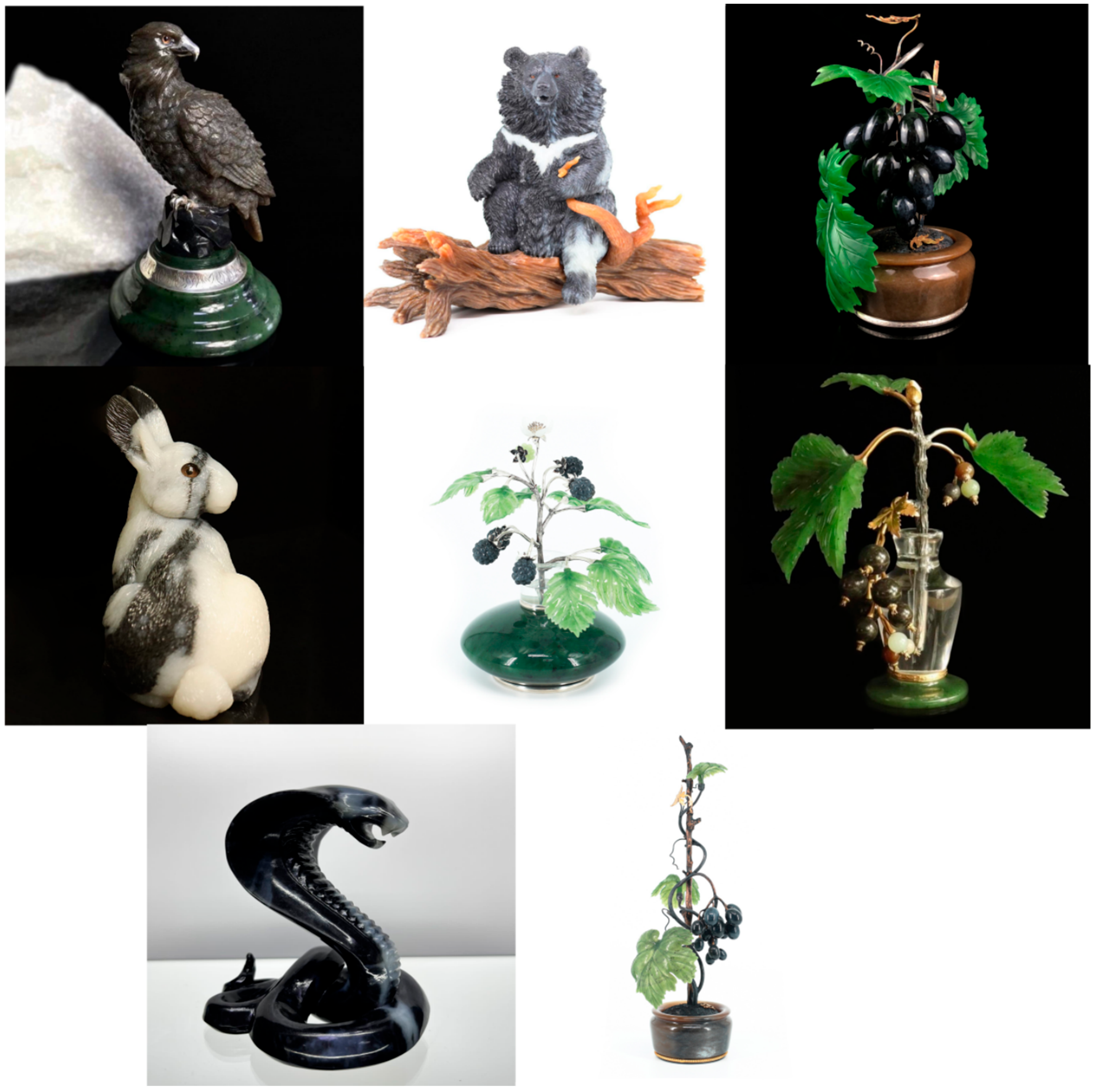




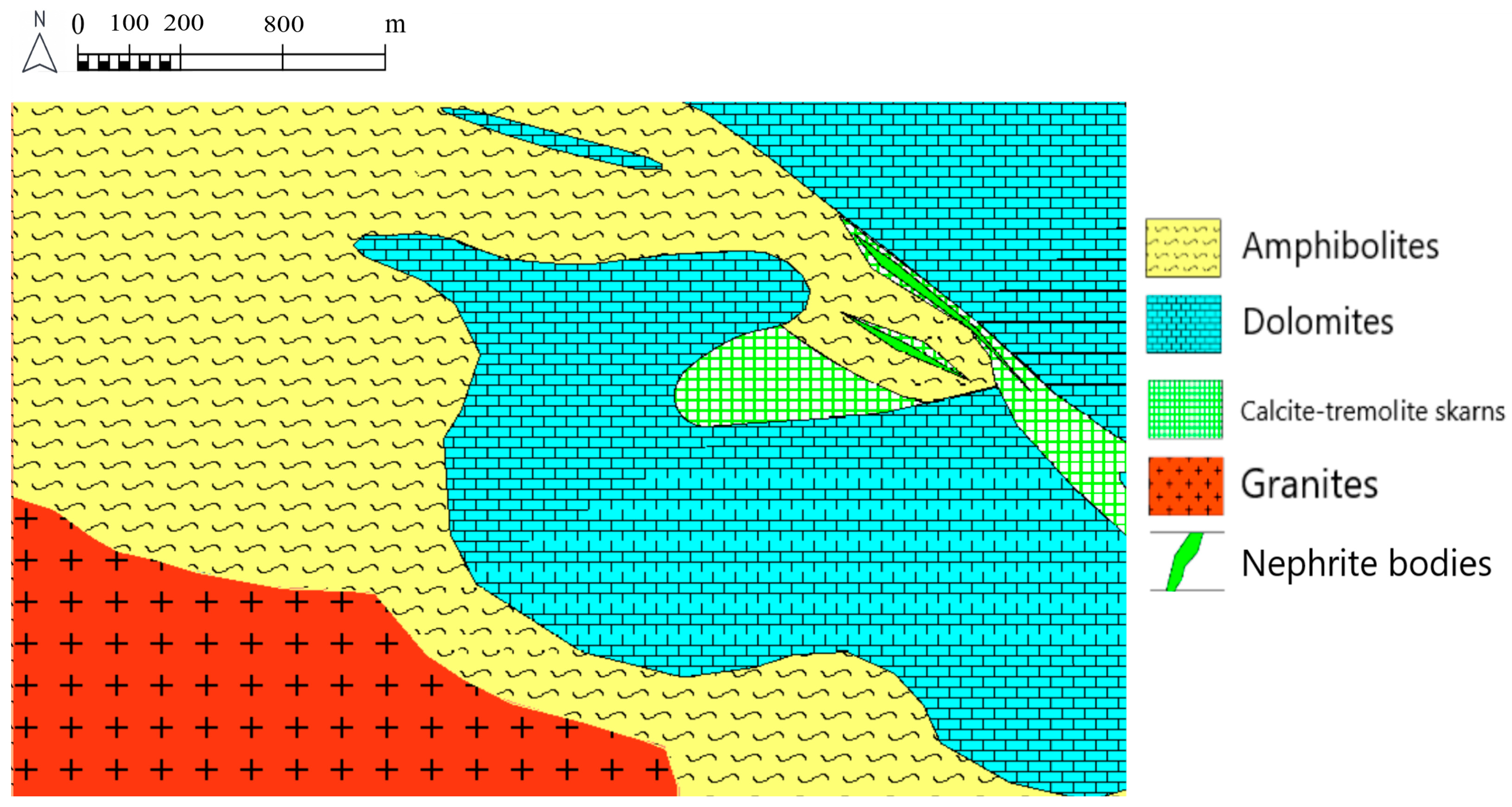
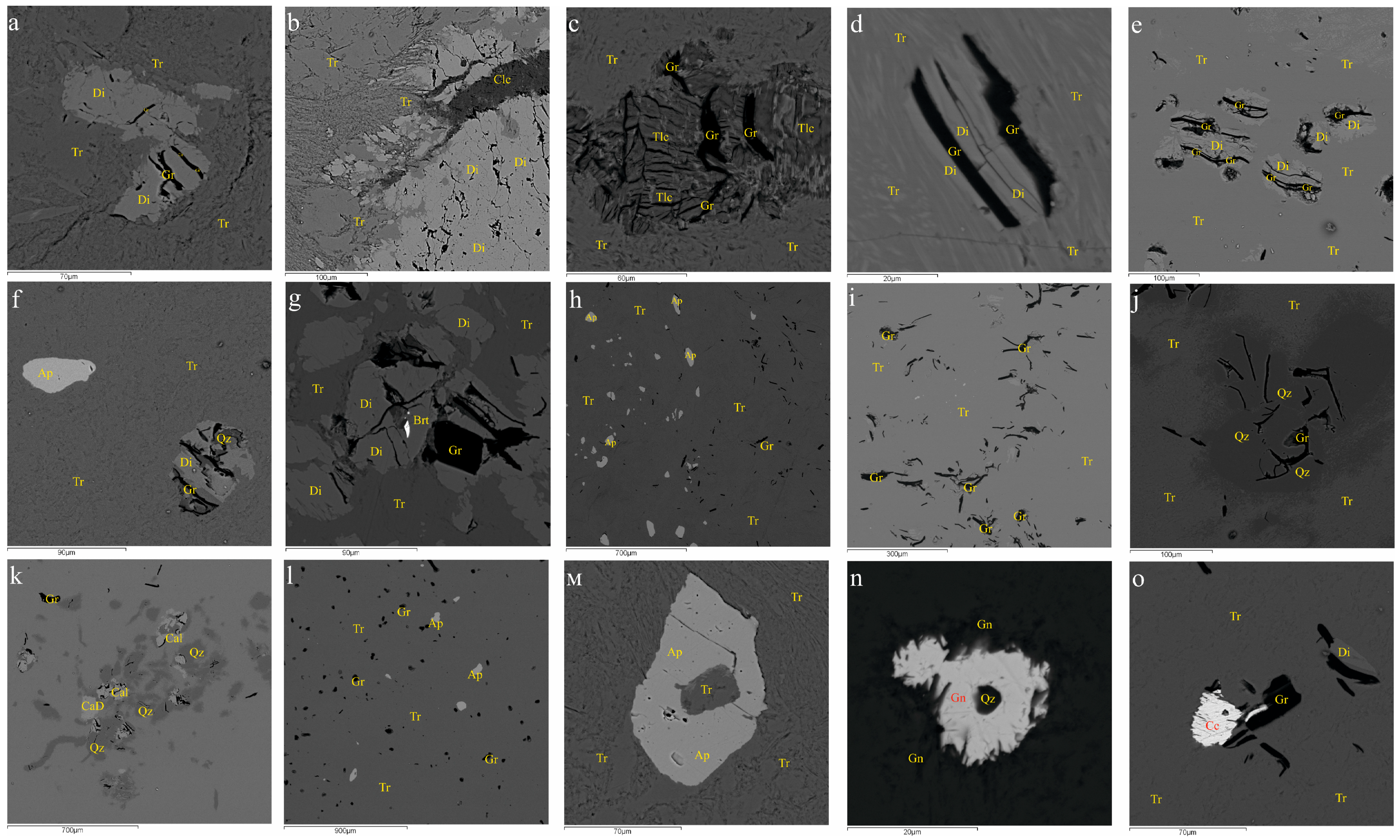
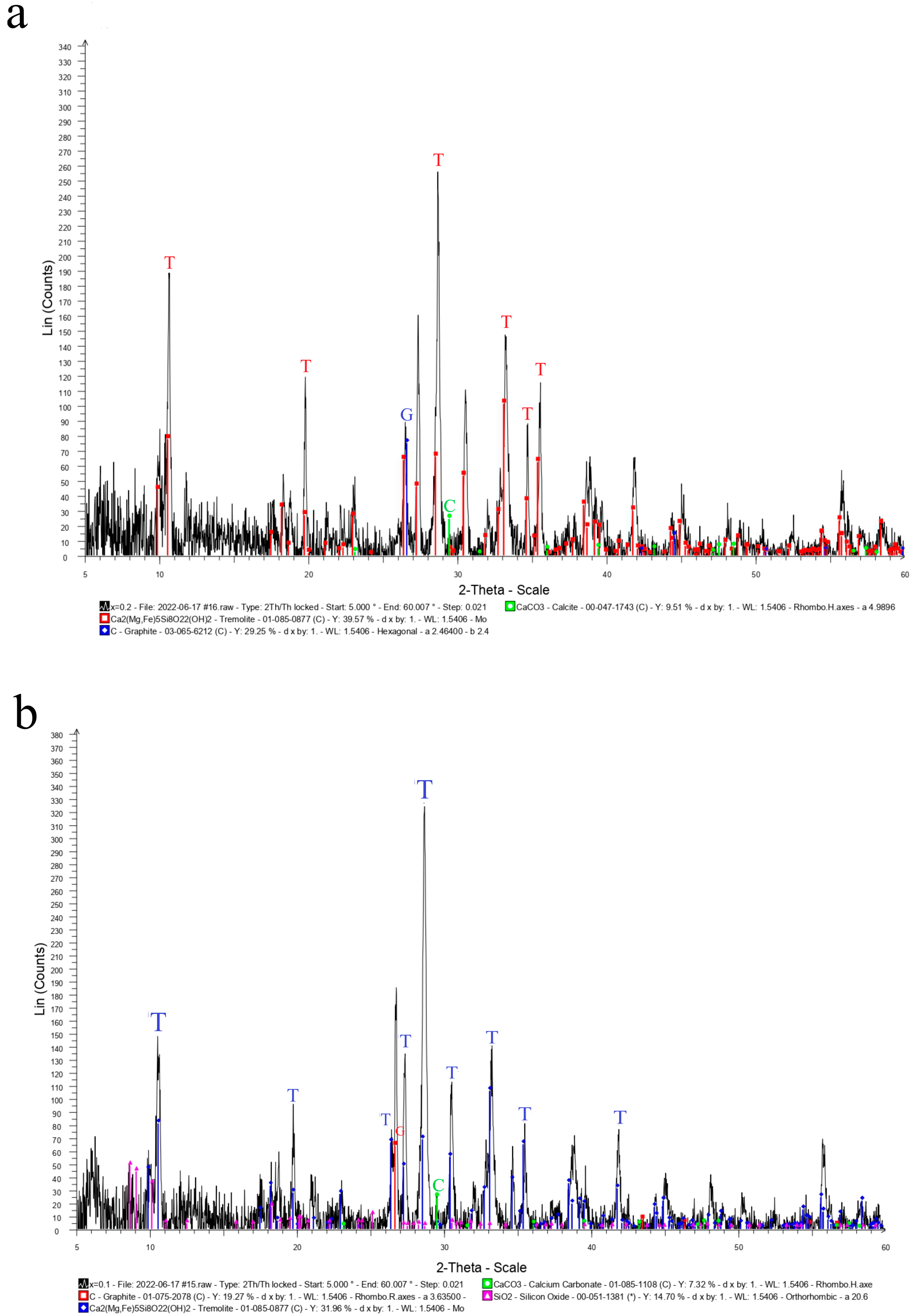

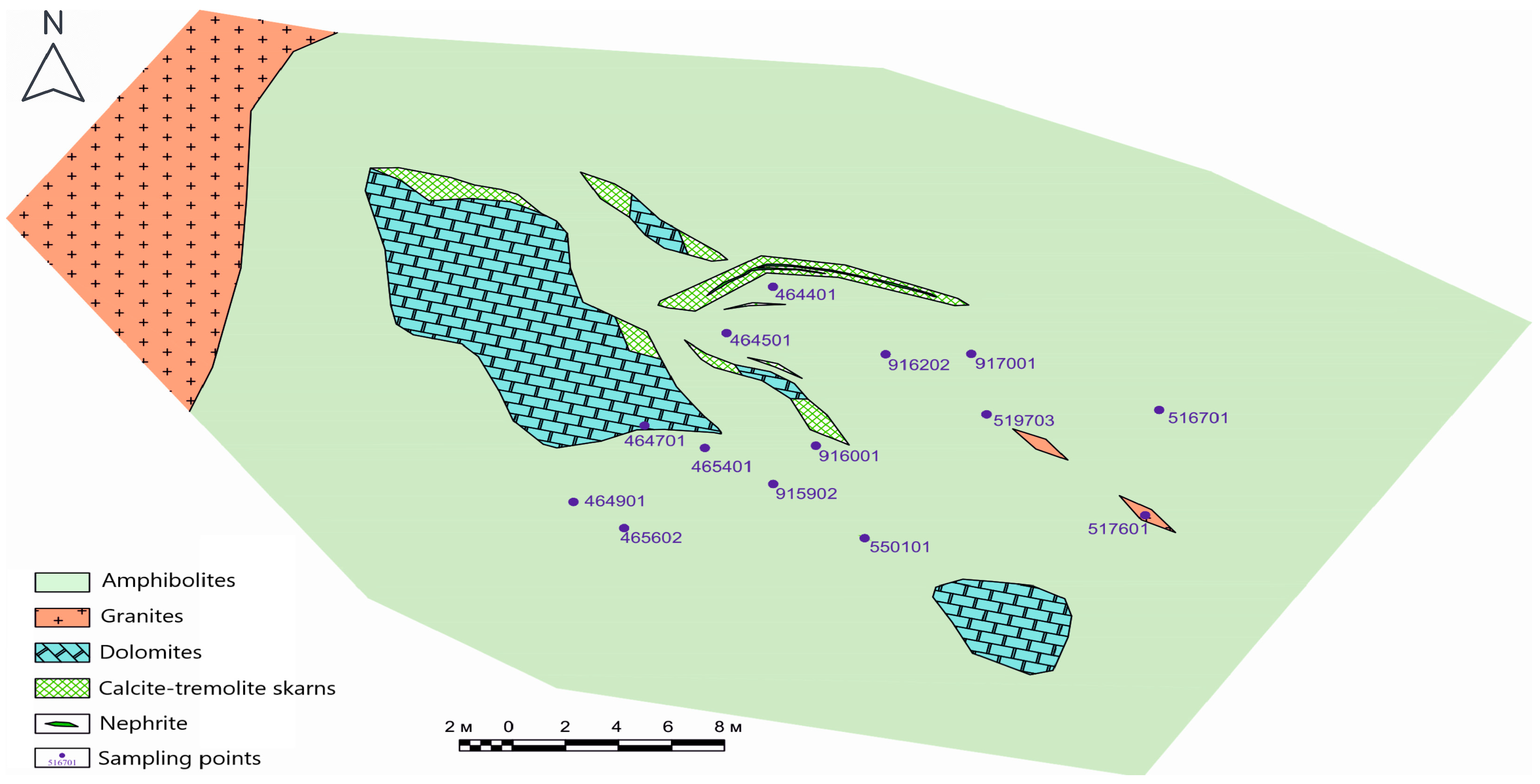

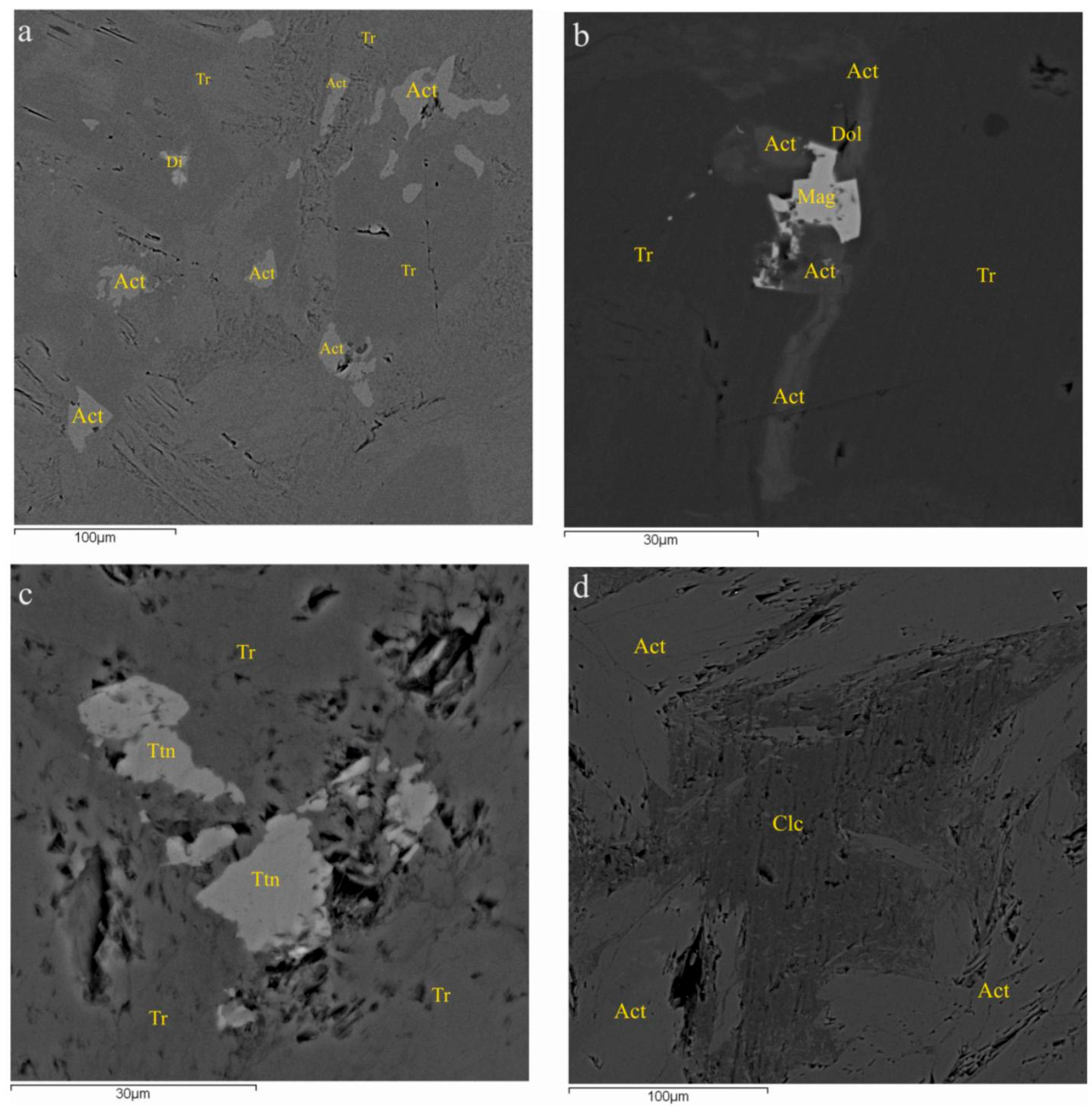
| Tremolite n = 96 | Diopside n = 60 | Chlorite n = 9 | Prehnite n = 12 | Talc n = 6 | ||||||
|---|---|---|---|---|---|---|---|---|---|---|
| Mean | Range | Mean | Range | Mean | Range | Mean | Range | Mean | Range | |
| SiO2 | 58.24 | 55.20–62.02 | 55.29 | 52.16–58.32 | 31.95 | 34.12–36.90 | 43.86 | 41.41–44.31 | 54.08 | 51.37–56.99 |
| Al2O3 | 0.56 | 0–2.14 | 0.78 | 0–2.83 | 14.87 | 12.92–16.74 | 24.51 | 23.41–25.32 | 3.36 | 2.46–4.14 |
| FeO | 0.08 | 0–0.87 | 0.01 | 0–0.37 | 0.42 | 0–0.68 | 0 | 0 | 0.12 | 0–0.39 |
| Fe2O3 | - | - | 0.04 | 0–2.23 | - | - | - | - | - | - |
| MnO | 0 | 0 | 0 | 0 | 0.03 | 0–0.28 | 0 | 0 | 0 | 0 |
| MgO | 23.49 | 21.56–26.05 | 18.04 | 16.40–20.23 | 33.87 | 31.49–35.35 | 0.42 | 0–1.04 | 27.73 | 26.52–30.56 |
| CaO | 13.49 | 11.67–14.89 | 25.89 | 20.27–27.75 | 0.57 | 0–2.15 | 27.78 | 27.12–28.64 | 2.23 | 1.34–3.79 |
| Na2O | 0 | 0–0.36 | 0.01 | 0–0.77 | 0 | 0 | 0 | 0 | 0 | 0 |
| K2O | 0.02 | 0–0.45 | 0 | 0 | 0 | 0 | 0 | 0 | 0 | 0 |
| V2O3 | 0 | 0 | 0 | 0 | 0 | 0 | 0.03 | 0–0.35 | 0 | 0 |
| F | 0.07 | 0–1.57 | 0 | 0 | 0 | 0 | 0 | 0 | 0.29 | 0–1.73 |
| Cl | 0 | 0–0.17 | 0 | 0 | 0 | 0 | 0 | 0 | 0 | 0 |
| Total | 95.95 | 100.06 | 81.71 | 96.60 | 87.81 | |||||
Disclaimer/Publisher’s Note: The statements, opinions and data contained in all publications are solely those of the individual author(s) and contributor(s) and not of MDPI and/or the editor(s). MDPI and/or the editor(s) disclaim responsibility for any injury to people or property resulting from any ideas, methods, instructions or products referred to in the content. |
© 2025 by the authors. Licensee MDPI, Basel, Switzerland. This article is an open access article distributed under the terms and conditions of the Creative Commons Attribution (CC BY) license (https://creativecommons.org/licenses/by/4.0/).
Share and Cite
Kislov, E.V.; Kotova, I.Y.; Posokhov, V.F.; Trofimov, A.V.; Khromova, E.A. Composition and Genesis of Dark Dolomite-Type Nephrite in the Kavokta Deposit, Middle Vitim Mountain Country, Russia. Geosciences 2025, 15, 398. https://doi.org/10.3390/geosciences15100398
Kislov EV, Kotova IY, Posokhov VF, Trofimov AV, Khromova EA. Composition and Genesis of Dark Dolomite-Type Nephrite in the Kavokta Deposit, Middle Vitim Mountain Country, Russia. Geosciences. 2025; 15(10):398. https://doi.org/10.3390/geosciences15100398
Chicago/Turabian StyleKislov, Evgeniy V., Irina Yu. Kotova, Viktor F. Posokhov, Artem V. Trofimov, and Elena A. Khromova. 2025. "Composition and Genesis of Dark Dolomite-Type Nephrite in the Kavokta Deposit, Middle Vitim Mountain Country, Russia" Geosciences 15, no. 10: 398. https://doi.org/10.3390/geosciences15100398
APA StyleKislov, E. V., Kotova, I. Y., Posokhov, V. F., Trofimov, A. V., & Khromova, E. A. (2025). Composition and Genesis of Dark Dolomite-Type Nephrite in the Kavokta Deposit, Middle Vitim Mountain Country, Russia. Geosciences, 15(10), 398. https://doi.org/10.3390/geosciences15100398







